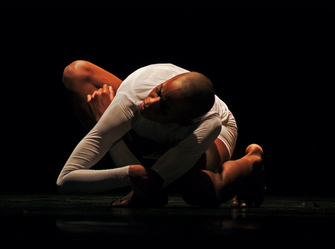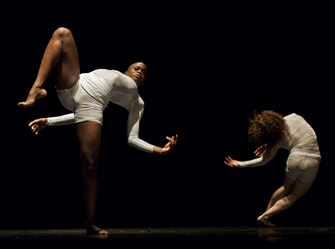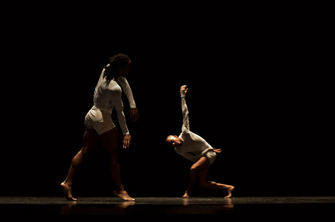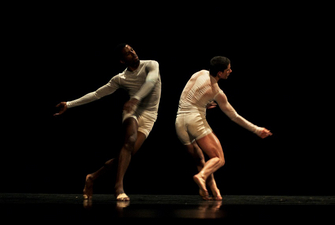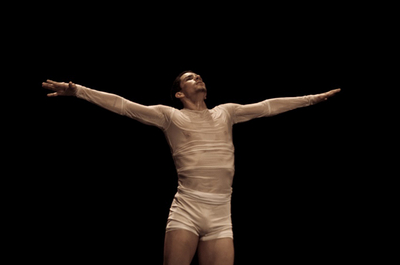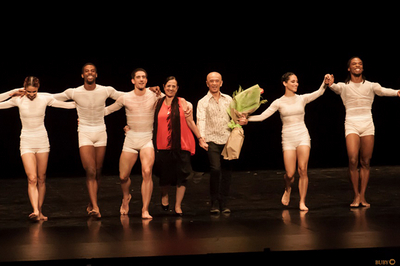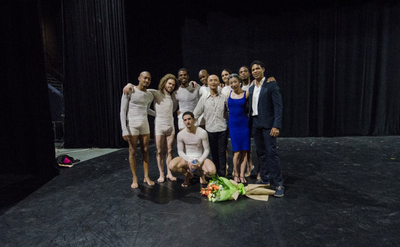Toward New Forms of Dance: Transcending both the everyday and work with a choreographer
In the spring of 2018, two collaborative projects in contemporary art and dance were held in Havana in commemoration of the 120th year since the first Japanese immigrants arrived in Cuba. In the area of dance, the world-renowned choreographers, Saburo Teshigawara and Rihoko Sato, who are also Japan's leading dancers, took up temporary residence in Havana, where for three weeks they worked together with dancers from a local dance company, Acosta Danza, to carry out creative activities and stage a new production called One Thousand Years After. On April 6, the world debut of the work was successfully performed at the Gran Teatro de La Habana, known normally as the "Alicia Alonso" Theater. Upon his return to Japan after giving three public performances in Cuba, Teshigawara was asked about the processes and results of his creative activities with the Acosta Danza, which has developed unique methods at its foundation.
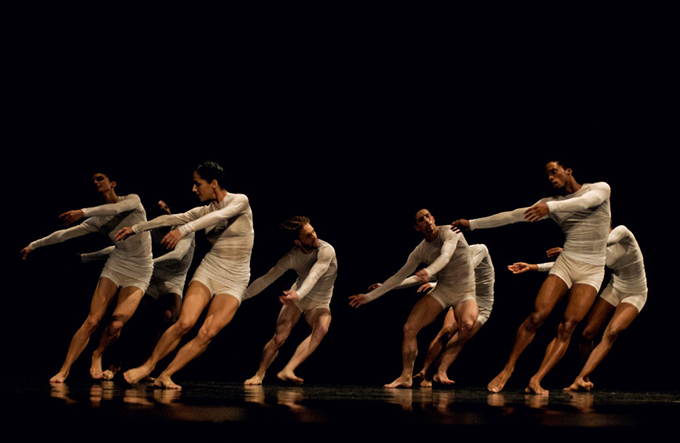
Scene from Acosta Danza's debut of One Thousand Years After.
Photo: Yuris Nórido
—Please describe the events leading up to your acceptance of the project in Cuba.
I had been interested in Cuba for a long time, given its rich musical culture, as well as because of the dancer Alicia Alonso. In 2012, when Rihoko Sato won the Premio Positano prize for the "Most Outstanding Female Dancer on the Contemporary Scene" at the Léonide Massine Competition in Italy, Alonso was given a lifetime achievement award. As she had lost her sight, Alonso had to be supported as she walked onto the stage. Sato was thus blessed with the opportunity of standing on the same stage as one of the world's top dancers—one whom she deeply respects.
I had never worked in Cuba before, moreover it had never entered my mind that I would ever get the chance to do so. The person in charge of the project at the Japan Foundation, Noboru Futako, came to KARAS Apparatus (Ogikubo, Tokyo) many times to explain it. I decided to accept the project because the people at the Japan Foundation were so enthusiastic about it, convincing me that it was all right to pursue. As a matter of fact, I had no knowledge of how to put on productions in Cuba, unlike in Europe and North America, so it would have been difficult for me and my group alone to have put something on ourselves, given such matters as preparation, communications, confirmations, and contracts.
—What kind of dance company is the Acosta Danza, with which you collaborated this time?
It is a young company composed of some twenty dancers, many of whom are in their early 20s, with the most senior being around thirty years old. Although the majority had been trained at the Cuban National Ballet School, there were some who had learned entertainment-style dancing other than ballet in parts of the country outside Havana. The company itself is quite new, having been established just three years ago by the Cuban Carlos Acosta, formerly a principal with The Royal Ballet of Britain, and who currently serves as the group's artistic director. It still does not have a broad repertoire, nor has it given many performances, so few people have heard about it. Despite that, the troupe has already made a U.K. tour, from what I have heard. There are still some rough edges to its production base, and I don't think that the performance this time would have been possible without the resources of the Japan Foundation. The creative work we staged was thus extremely important, not only as a commemorative event between Japan and Cuba, but also for the company itself.
Other scenes from the debut of One Thousand Years After.
Photos: Yuris Nórido
—Please tell us about the creation of One Thousand Years After produced together with the dancers from Acosta Danza.
First of all, last December (2017), when I was in Cuba the first time, I selected the dancers who would appear in the performance. After that, in the middle of March of this year, I made my way back to Havana to start preparations for creating the dance piece. The performance was to be done by eight people, each with his or her own individuality, with Javier Rojas, a brilliantly talented dancer, who took the lead so as to establish the entire flow of the work. Workshops were given during the first three-fourths of the rehearsals to deepen the dancers' understanding of the basics, with the remaining time spent on concentrating on creating the whole piece. Until that final creation period, I intentionally progressed with the preparations without giving actual shape to anything. If one races to give form to something, one tends to veer toward the judgment of whether that thing is effective or not, so I tried to avoid such a situation. As far as I am concerned, it is important to search for new values, so I was looking for the beauty that exists beyond that point. In the long run, I ended up deciding upon the whole composition of the piece and the timing of the moves, but left the bulk of the details of those matters up to the dancers. My basic concept is not to interrupt the flow, but to allow the stream that gushes forth to keep on flowing. Throughout the entirety of the dance piece, I utilized curving, liquid movements, such as having the dancers brush past one another, running as they move, and to lurch.
The initial and final scenes of One Thousand Years After were graced by solos by Javier Rojas.
Photo: Yuris Nórido
—The dancers were only given a short time to learn your unique dance methods before their first performance, so it must not have been very easy for them. How did you teach them?
At first, I did not begin with having the dancers dance per se, but rather had them feeling or sensing how their bodies moved. Just as in physical education classes, I started with having them relax, shake their bodies, and walk and run. I do this with every project, whether it be a new Paris Opera Ballet production or a workshop for amateurs, with the intention of getting them first to perceive how their bodies move realistically and materially. In doing so, they arrive at a stage known as "automatism," that is, going through their actions without conscious thought or intention. For instance, as a person raises his or her hand or arm, the way the body is joined together causes several organic movements to be made consecutively, such as initially swinging the hand or arm downward. My aim is to take everyone to the point where they can feel and use that principle for himself or herself.
Normally, in choreography or in the acquisition of new techniques, one memorizes things through repeated actions. In my method, however, I don't have the dancers learn certain moves by heart, but instead encourage them to open their consciousness or bodies as long as it is needed for them to feel things afresh. In European thinking, specific actions are made linearly toward a specific result that one aims to achieve. I, on the other hand, believe that it is more important to have the body accept or receive something, rather than to have it store memories, because the body absorbs things through the process of forgetting them. Of course, memories are essentially not preservable things, so to speak. It is not thus a function of the dancers simply replaying specific moves that they have memorized, but of getting them to attempt to carry something out again afresh, be it the music, or the breathing, or the steps, or the posture. If something starts out all right, the rest ought to flow naturally, like a river or water, also spontaneously guiding the body's movements. The body is meant to be moved with a sense of necessity—that is, the dancer does something that needs to be done, without being conscious of it, just as with the circulation of the blood or breathing. Employing certain terms or phrases of speech, I escort or guide the dancers to the point at which they can feel that for themselves. My technique is one of continually creating the sense of necessity [in the dancers] at all times.
—Can you tell us more specifically how you carried out your instruction?
I just keep on talking the whole time. That is, I continue making continual comments without actually demonstrating any model or sample moves. With the dancers sharing an understanding with me of such phrases as "loosening up," dance, too, can be expressed through verbal communication, just as in the case of language, musical scales or argot, and its contents can be expressed in a pure fashion. When people try to recreate, in concrete form, something that they have memorized after only watching it, discrepancies inevitably emerge in how they take shape. However, the verbalization of a move necessitates giving form to its essence, rather than just copying it. From the very beginning, I employ metaphors and the like to repeatedly make the point that the body is capable of moving through words, and that words have the power to make the body move. For example, any movement involves complementary actions and counteractions—such as crouching down before jumping, or kicking back one's foot before running forward—meaning that before any action is taken, there must first be some kind of relaxation or slackening. In other words, the act of relaxing produces a movement—such as curving or centrifugal motion—that is different from linear motion, and which comes to link those motions with the composition of the space, including the positions of the dancers and their movements from one place to another. The method of ballet involves the idea of transferring the moves made by the dancer at a certain place to another. In shogi (Japanese chess), a piece with potential power or strength is moved across the board. In my style of dance, everything is accompanied by movement. That is to say, it is not a matter of getting stationary things to start moving, but rather a situation in which things are consistently in motion; namely, everything exists in a space that is always moving.
The ballet mistress Clotilde Peón (center) was able to translate Saburo Teshigawara's ideas and convey them to the dancers precisely.
Photo: Buby
—Weren't there any language barriers?
Though a few of the dancers could speak English, the ballet mistress Clotilde Peón was kind enough to translate my English directions into Spanish for the rest of them. Since my instruction style is to continually talk, I'm sure it must have been quite a chore for her. While some of the dancers could speak English more fluently than her, what was marvelous about her was how she could get to the bottom of my ideas and the background to my comments while I was talking, and then convey those things to the dancers in an extremely accurate way. She is a wonderful educator, with a long career of having danced for the Alonso ballet troupe, so she understood that my talk was more concrete than mental, as well as the importance of words to the body. I thought that gaining such mutual understanding was crucial to the success of the project. In international exchanges of culture or art, what is important is not one side doing the giving and the other side doing the receiving, but instead how well each side understands the other. If understanding is enabled, theories and ideas are retained as memories and techniques. Although my job is the creation of new dance works, it does not stop there. I want the dancers to take my suggestions and apply them so as to put their potential into play more successfully—induced by their own ideas and desires—in order to make dance more enjoyable and interesting.
—How did dancers feel once the performance was finished?
Their faces were all brimming with wonderful smiles. They had taken the opportunity given to them, and got a sense of fulfillment having successfully responded to it. No one had dropped out from the project halfway, so everyone was able to achieve a state of happiness. The first work performed in the program was Lost in Dance, a new duet by Rihoko Sato and me, with the second work by the Swedish choreographer Pontus Lidberg, and the third work One Thousand Years After. Having watched all the performances on each of the three days that they were staged, I felt that each was done distinctively and interestingly. Unlike choreographed works where frequency, angles and other similar things are all precisely defined in advance, I had designed the moves as part of a total structure or flow, letting the dancers modify the details therein even if they were performing the same piece again.
—What sort of aspirations did the young dancers have toward dance and their own careers?
I never talk about such things, so I don't really know. My work is the creation of dance pieces, and in that process, I never ask dancers why they want to dance or what they are dancing for, since I believe that what they need to do is simply to dance. The main issue for dancers is to have the right technique, as well as the mindset to translate that into reality. In creative works where time is limited, one must pursue that which needs to be radically resolved. My job is not to force dancers to deal with their dreams, but instead what they despise the most. In a sense, they are being forced onto a precipice, from where they pursue what it is that they want to say or express. Rather than having dancers ask what is needed while they are in a calm, peaceful place, what is important in dance is for them to maintain a state of decisiveness and resolution in the most hazardous kinds of places. That also leads to the issue of how one should live every second of one's life. It wouldn't make much difference to the world if works were not produced for dance. Still, why do people venture to do so? Unless one maintains the intention to do so within one's mind, it would be impossible.
In dance, the will and desire of the dancer both need to be expressed. I often say that on the stage, the dancer is of prime importance, with the choreographer relegated to a secondary existence. What is going on is not the choreographer demonstrating his/her choreography; it would be dull unless what is being created by the dancer has some value. Maurice Béjart (1927-2007) once said that the 20th century was the age of the choreographer, but in more contemporary times, it is the dancer himself or herself who must transform and produce value. That does not mean following the logic of big markets, but rather having the kind of values, I believe, that ought to exist, which are narrower, more individual and less distinct, in the sense of being interesting rather than famous. Surely, each of the dancers of Acosta Danza carried out his or her work feeling that he or she would bloom in the future. In that respect, it was quite interesting for me to work with that company, including its unconfirmed elements. I felt that I got the chance to meet very precious people.
—Did you get the impression that there was a temperament or disposition uniquely characteristic of Cuba—a place where you had never worked before?
I got the impression that music and dance run through their veins. What was interesting, though, was that while Cubans are intense on the streets, they were unexpectedly quiet on the rehearsal floor. When asked for their opinions, most would not comment much at all. And though they gradually came to answer me more and more, they differed from dancers from the West, who tend to quite aggressively voice their opinions. That is not to say, however, that Cubans are passive, but more that it probably owes to differences in our respective societies; it even came off as a kind of refinedness or modesty that does not draw clear distinctions between right and wrong. It is not a bad thing: I felt that it was their culture, and that it was a way of thinking that they had come to develop. Cubans are very strong people, whose values are distinct from those which seek newness and wealth in material and monetary terms. Still, that is not so much based on the socialist system, but stems more, I feel, from their knowledge of the struggles of their predecessors, that is, the people who built their society of today. I sensed that it should be viewed as what Cubans treat as important: a kind of refinedness, which is their culture.
—Was there anything that particularly struck you having lived in Cuba this time? Also, did you draw any special inspiration from your collaboration with the Cubans?
Although I was not alive back then, I felt that Havana might resemble how Japan must have appeared after World War II. While some of the streets are still run-down and in need of repair, there is little crime, and the police are not so visible. People can walk wherever they want, both in the daytime and at night. Their style of walking is not that of merely heading toward their respective destinations, but felt more like a situation in which one person's stroll would turn into a group of people walking together, with a crowd naturally developing. Perhaps there is an unspoken rule that we don't know about, I think. There are a lot of antique cars on the street, with people giving rides to each other after getting a signal. The Cubans are also tenacious people, having just gotten legal permission to carry out individual commercial activities a few years back, I hear. You can see people selling tea from small tables placed before their houses, for instance, or hawking used things while walking the streets. I also saw people fully laden with cleaning gear standing before apartment buildings who were advertising their cleaning services. Interestingly, I felt that such a style also matched my own nature.
While I feel that dance, in a certain respect, ought to be part of daily life and society, I also believe that its search for a separate dimension or values disengaged from everyday reality may represent a kind of human desire or dream. Although those values are not promised or guaranteed, the ability to sense a person's will or thinking through dance is a beautiful thing. For that reason, I think that dance is important, irrespective of differences in social or political systems or in ethnicity. Many things are criticized in the contemporary era, being described simply as either good or bad, but there are things in the way people lead their lives about which judgments cannot easily be rendered. People's actions should not be judged as good or bad, but should instead be looked at for their inherent value.
It will be interesting to see how contemporary dance, which is viewed as Western culture, will develop in Cuban society from now on. I hope that Cubans will take good care of their culture.
The artistic director of Acosta Danza, Carlos Acosta (far right) portrayed with the smiling dancers dressed in white (back row, plus one crouching) after the performance, along with Saburo Teshigawara and Rihoko Sato (front center).
Photo: Kike
Interview/text: Sae Okami
Back Issues
- 2023.12. 7 Movie Theaters aroun…
- 2023.6.16 The 49th Japan Found…
- 2023.4.24 The 49th Japan Found…
- 2022.12.27 Living Together with…
- 2022.12.27 Living Together with…
- 2022.8.12 Inner Diversity <…
- 2022.3.31 The 48th Japan Found…
- 2022.3.29 Beyond Disasters - T…
- 2021.11.29 Crossing Borders, En…
- 2021.4.13 Crossing Borders, En…


